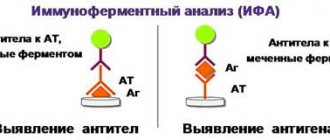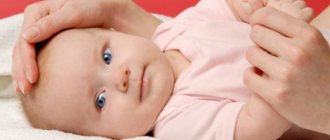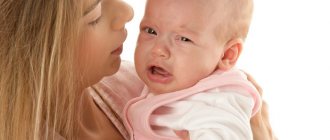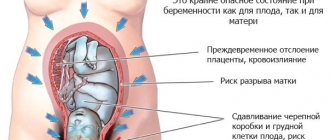We are all familiar with hiccups - involuntary contractions of the diaphragm. Although a little annoying, hiccups are harmless in most cases. Contractions of the diaphragm in infants are also quite common. However, if the baby begins to hiccup after laughing a lot, and does this for a long period, you should pay attention. Why do hiccups occur when the baby laughs? What are the consequences and how to overcome it? The answers to these and similar questions are in the article.
If your child regularly hiccups after laughing, it’s worth thinking about the reasons for its occurrence.
Why does a child hiccup?
Hiccups in newborns, as in adults, begin due to spasmodic contraction of the diaphragm - the muscle that separates the chest cavity from the abdominal cavity in our body. The diaphragm is involved in breathing: it tenses, allowing air to enter the lungs, and then relaxes, displacing it. When something irritates the diaphragm, the impulse rushes to the brain and then returns, causing the muscle to contract sharply. The lungs suddenly suck in air, and it breaks through the slammed vocal cords - a deep breath occurs with the sound “hic”.
A newborn may hiccup several times a day for 10 to 30 minutes. There's nothing wrong with that. The baby’s nervous, respiratory and digestive systems are in the process of formation, and while their work is improving, many factors can provoke hiccups. Most often this is:
- Overeating, swallowing large amounts of air, or increased gas production. In all these cases, a distended stomach or intestinal loops swollen with gases put pressure on the diaphragm, and it contracts in response, causing hiccups in the newborn.
- Thirst, overheating, dry air. The mucous membrane of the oropharynx dries out, irritation begins in the respiratory tract, which spreads to the phrenic nerves.
- Foreign odors, intense aromas, dust, tobacco smoke. Babies have a sensitive respiratory system; any irritant in the air can cause a cough. This in turn will irritate the diaphragm.
- Fright, loud sounds, a day full of emotions. Anything that can overstimulate the nervous system can also cause hiccups.
- Hypothermia. When a child is cool, he tenses his muscles, including his abdominal muscles. Because of this, the stomach begins to put pressure on the diaphragm.
It turns out that hiccups are a useful phenomenon that lets parents know if something is going wrong. Pay attention to the feeding technique and mode, the child’s body temperature and his emotional well-being, the temperature and humidity in the room. Often it is enough to remove the irritating factor for the attacks of hiccups to subside.
Laughter in a child's life
Laughter, as a physiological feature given to every person, is an indicator of positive emotions and good mood. A person laughs from hearing a joke or realizing that the situation is comical; by laughing, a person also shows a friendly disposition towards the interlocutor or a desire to get closer to the person. Laughter is one of the ways of communication that is understandable to all people and has no speech barrier.
Laughter is a complex motor act, consisting of contraction of the muscles of the diaphragm and accompanied by the work of the vocal apparatus. The center of laughter is localized in the brain stem, and the cerebellum, midbrain and hypothalamus are involved in the organization of laughter.
By the time of birth, the child does not know how to laugh, and his only means of communicating with the world is to cry. He shows them his needs and satisfies the emerging needs up to a certain age. A newborn baby may smile, but this happens involuntarily. The smile of a newborn is not a positive emotion, but a spontaneous contraction of the facial nerves as a result of the formation and development of the nervous system. Only a peaceful environment, a feeling of comfort and safety can contribute to the further development of pleasant sensations. The baby consciously begins to smile by the age of two months; he copies his mother’s smile and thus expresses his pleasure.
A baby's harbinger of laughter is an energetic smile. The child's first attempts to laugh appear as early as 2-2.5 months; they often resemble cackling, so they go unnoticed. And only from 3-4 months old children’s ringing laughter appears. Children laugh in response to being tickled, being rubbed on the tummy or thrown in the air, and also when the child hears unusual sounds made by adults.
The main evidence of a child’s mental health and harmonious development is laughter.
No one will be indifferent to the baby's boisterous and sincere laughter. Babies who have not yet even learned to speak laugh especially touchingly.
The baby grows, accumulates impressions while awake, and this can be expressed by laughter in his sleep. There is no need to be surprised or afraid of this; such laughter is a unique stage in the formation of a child’s mental and emotional development.
With the first laugh, parents not only have joy, but also questions. Thus, mothers often note that after laughing, the child begins to hiccup. This is quite normal, because the respiratory system is involved during laughter. A child's weak diaphragm experiences previously unusual spasms, which lead to hiccups after laughter. A mother’s kind smile, playing together with a child, carrying a baby in her arms, reading rhymes, pleasant music, bright and beautiful pictures, singing songs cause the manifestation of joyful emotions, form a contented smile and cause ringing laughter. Smile, laugh with your children and be happy!
Information prepared for you by:
Lyalikova Yulia Viktorovna - pediatrician, gastroenterologist. Conducts a reception in the Children's building on Usachev.
How to stop causing hiccups
Don't overfeed your baby. Keep in mind that breast milk is digested within 2.5-3 hours, formula - 3-4.
Maintain intervals between feedings and at the same time do not make them too long. A hungry baby will begin to worry and rush while eating, and this can cause hiccups.
If you give a mixture, follow the dosage according to age. With natural feeding, there is no need to tear the baby off the breast before he does it himself. But when there is a lot of milk, and there is a suspicion that the baby is overeating, pumping before feeding will help.
Avoid situations in which the baby swallows air along with food. When breastfeeding, make sure your baby latches onto the entire areola of the nipple. Express a little before feeding if your baby is constantly choking and cannot cope with the flow of milk.
When bottle-feeding, hold the bottle at an angle so that the nipple is filled with the mixture. Use a bottle with a small hole. A simple test will help you make the right choice: fill the bottle with liquid and turn it upside down - the contents should drip slowly. Immediately after eating, hold the baby in a column for 5-10 minutes - this will help him burp and get rid of excess air.
Monitor the microclimate. In a newborn's room, it is usually recommended to keep the temperature within 22 degrees. Dr. Komarovsky considers 18-19 degrees ideal. And this seems to be true.
The child should breathe clean, cool, moist air. And if he is cold, which he can signal by hiccups, just dress him a little warmer. And do not forget to humidify the air to the optimal 50-70%. If you don’t have a humidifier, place a container of water near the radiator, hang a wet towel, spray water from a spray bottle, and do wet cleaning more often.
A newborn may hiccup both when he is hypothermic and when he is overheated. It is important not to allow either one or the other. The indicators are the back, bends of the arms and legs. Touch them, if they are wet, then the baby is hot, if they are cold, he is freezing. Cold hands, feet and nose are not indicators that the child is cold. Focusing only on hiccups is also wrong - the reason may be different.
Pay attention to your baby's emotional well-being during a hiccup attack. Perhaps the reason was fear. Take the baby in your arms, stroke him, dim the lights, ensure silence, hold him to your breast for a while so that he calms down.
How to help your baby overcome hiccups?
- Ask your baby to breathe in 1, 2, 3, that is, counting.
- Let the baby stand up, raise his arms up and stretch, while it is important to take a deep breath and exhale.
- To perform the next exercise, you will need a paper (not plastic) bag - let the child breathe into it, performing quick inhalation and exhalation actions.
- The most common way is to give the baby some water to drink. Swallowing movements calm the diaphragm.
- A modern method of dealing with hiccups, suggested by foreign doctors, is to eat a spoonful of sugar. You don't need to drink it, just chew it, and that's it - it works.
- You can eat a slice of lemon, but if you have to choose, a spoonful of sugar will be more to the taste of little fidgets.
- You can chew the crust of the bread. In cases when the baby needs to eat something, be extremely careful so that the baby does not choke while making involuntary contractions.
- There is another way: the child needs to lean forward, put his hands behind his back, clasp them, and in this position, drink a glass of water.
- So that the little one doesn’t get too worried and nervous by hiccupping, accompany your actions with a fun fun plot against hiccups: “Hiccup-hiccup, go to Fedot, from Fedot to Yakov, from Yakov to everyone.”
When should you go to the doctor with hiccups?
You should consult a pediatrician when hiccups in a newborn do not go away for several hours or even days. At the same time, other symptoms will indicate the development of pathology. The baby frequently and profusely burps or vomits during feeding, eats poorly, is capricious, cries for no apparent reason, sleeps restlessly, coughs, and chokes.
The child may develop a fever, seizures, and movement disorders in the arms and legs. The clinical picture will depend on the nature of the disease. This may be a pathology of the gastrointestinal tract, respiratory system, or central nervous system disease. The child must be examined by specialists, do the necessary tests and prescribe treatment.
Why does my baby hiccup so often?
A special partition between the chest and abdominal cavities, the diaphragm, is responsible for the occurrence of hiccups in the human body. The vagus nerve, passing from the chest cavity to the abdominal cavity, squeezes along with the esophagus through a narrow opening in the diaphragm. Irritation of the vagus nerve can occur with general overexcitation, accompanied by a sharp breath (screaming, fear), a sharp change in the fullness of the abdominal or thoracic cavity (overeating, belching, bowel movements), as well as with an uncomfortable position when the nerve is compressed. Rarely, although most often in children, hiccups begin with severe hypothermia as a systemic reaction. As can be understood from the explanation of the causes of hiccups, this phenomenon is harmless and passes rather quickly.
The physiological immaturity of an infant contributes to the more frequent occurrence of hiccups in him than in an adult. The muscles and nerve passages do not yet work well enough, and the “lifestyle” of the child in the first months is a provocation for the occurrence of hiccups: the baby eats a lot and often, does not always digest food well, he is moved often and sometimes in an uncomfortable position, and he often thinks expresses everything by screaming. How to help a hiccupping child?
These tips should be considered specifically as help in improving the condition, and not as eliminating hiccups as such. Why? Yes, because we already know that this is a spontaneous reaction, and we can only slightly influence the causes.
- warm the child if he started to hiccup on his own and was clearly hypothermic (he was lying undressed for a long time, the room was cool, he had a cold back in the area of the shoulder blades) - warmth, a warm hug from a loved one and an offer of breasts can quickly solve this problem;
- eliminate the cause of the nervous shock and calm the baby before eating, if he cried for a long time or too much - this way the sucking will be more uniform, it is possible to feed in several stages of attachment to the breast (or other source of nutrition).
- help burp air if the child sucked greedily and clearly swallowed it. It is worth mentioning that with proper breastfeeding, this situation is almost impossible.
- change the child’s position to a more relaxed one, with less pressure on the abdominal cavity.
- wash a hiccupping child after profuse bowel movements or regurgitation, rock him and... feed him again: this way he will quickly restore his emotional background and fill the abdominal cavity with a distended stomach.
Symptoms of hyperkinetic disorder in children
It is quite difficult to suspect the disease in infancy; the main manifestations of the disease occur in the preschool periods of adolescence: at 3 years and 6–7 years. Parents may notice various involuntary motor acts, which include:
- teeth grinding (bruxism);
- guttural cough;
- rhythmic rocking of the body or head;
- nail biting.
The most pronounced symptom of childhood hyperkinetic disorders remains tics - involuntary contractions of the muscles of the neck, face, and shoulder girdle. In some cases, the twitching is accompanied by sound signals (vocalisms): laughter, screams, hiccups, coughing. Tics intensify if the child is worried, worried, is in an unfamiliar environment or meets new people.
Other signs of the disorder may include:
- chorea - erratic, excessive body movements, reminiscent of a chaotic dance;
- tremor of the hands, feet, chin, tongue;
- torticollis - a condition in which the child’s head takes an unnatural position with persistent rotation and tilt;
- hemiballismus – sharp, “throwing” movements that occur suddenly and predominantly on one side of the body.
In some cases, specific symptoms include stuttering, nocturnal enuresis, sleep and awakening disorders, and fear of sharp sounds and bright lights.
Hyperkinetic disorder is sometimes accompanied by increased impulsivity, the inability to do one thing for a long time, impaired concentration and attention, which is also characteristic of ADHD. In some cases, the opposite reaction is observed: a child with hyperkinesis prefers solitude, silence, calm, thoughtful activities.
Diagnosis of the disease
Recognition and treatment of hyperkinetic behavior disorder in children requires a comprehensive approach. The diagnosis is made based on a number of studies, which include:
- determination of neurological and psychological status using various techniques;
- assessment of the child’s medical history, environment, environment and living conditions;
- consultation with an ophthalmologist, psychiatrist, geneticist;
- electroneurophysiological examination;
- magnetic resonance or computed tomography of the brain;
- complex of laboratory tests.
The main task at the diagnostic stage is not only to identify the characteristic signs of hyperkinesis, but also to exclude other pathologies that may give a similar clinical picture, for example, epilepsy, Schilder-Addison syndrome.










